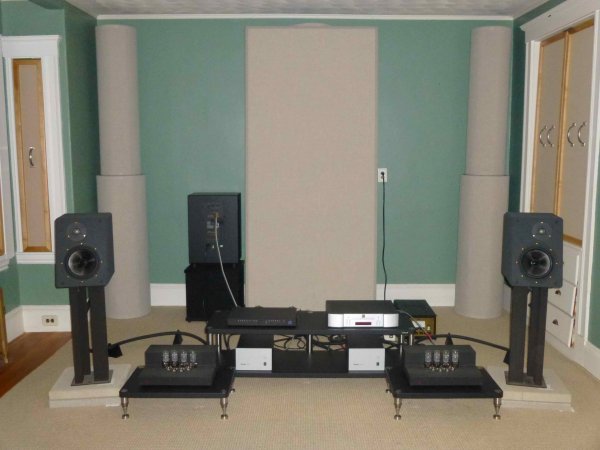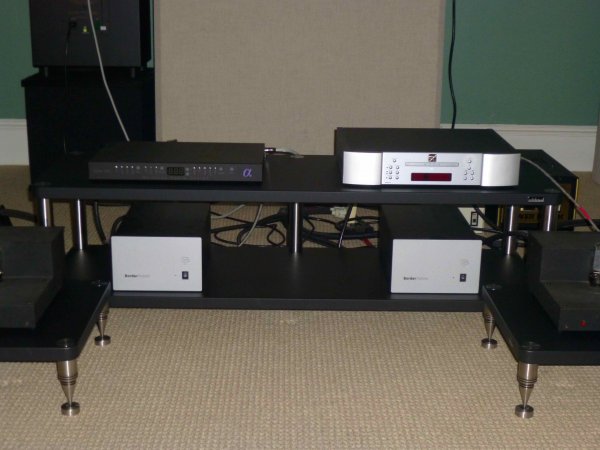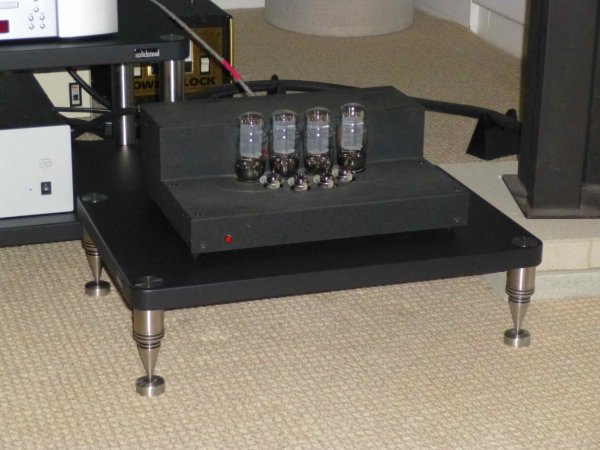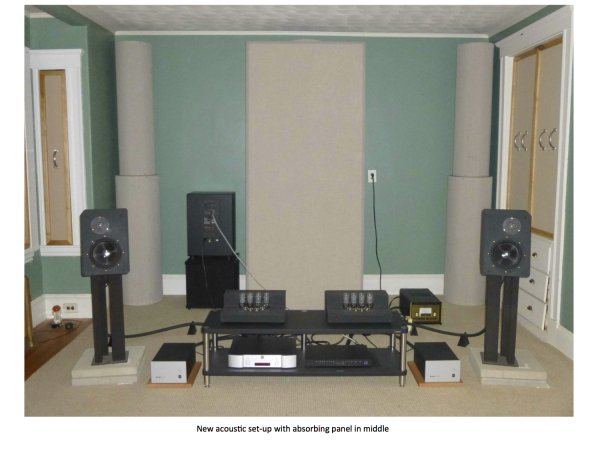
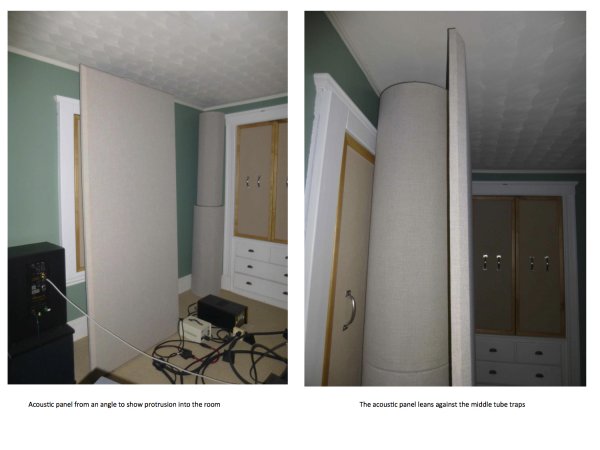
Lately I had been playing a bit more with the acoustics of my room. I bought two large absorbing panels (each 8 feet high, 3.5 feet wide) from Acoustics First, with the plan of covering the front wall with them, as they would expand sideways towards the central window from behind the corner tube traps. The presentation of sound had suffered from too recessed images in many cases, and so far every device that helped deaden the room behind the speakers up to the front wall (carpet and window plugs) had helped in pushing sonic images more forward. I wanted an even more forward presentation in many instances (while absolute depth of stereo imaging, locked in on a number of recordings, always had stayed the same), hence the absorbing panels.
Strangely, while the acoustic panels clearly work, as was obvious with a hand clapping test next to the front wall before and after installation of the panels, they did not help in moving images more forward. It seemed that, beyond the level of deadening of the front half of the room so far, the additional deadening did not help. On the other hand, the panels suppressed treble a bit, an effect not desired. So I decided to move them to the back wall behind the listening seat where they did not influence the sound but at least could be 'stored' in the room; due to their size it was impractical to move them to other rooms of the house. They were there to remain until I decided on further acoustic experimentation. Very recently I pursued the experimentation further, moving one of the acoustic panels
in front of the middle stack of tube traps (see images above; the panel has the same color as the tube traps, which is not accurately captured in the images), with the idea to move the middle reflection point behind the speakers further into the room, and yielding some deadening there, by providing a broader absorptive barrier. Now the middle tube traps function as a support for the acoustic panel, while they will still absorb bass frequencies from the subwoofer next to them, close to the front wall. The distance of the absorptive panel from the speakers is still considerable; the speaker drivers are at about 7 feet distance from the front wall.
The new arrangement worked: some too recessed images (e.g., some vocals) came more forward, and especially the clarity of sound improved; sounds far back in the soundstage now seemed less 'lost in space', and more defined in their presence. This was also beneficial for some piano recordings with the instrument at a distance in reverberant acoustic settings. There was no effect on perceived treble extension with this set-up.
I enjoyed my new sound a lot until, to my dismay, I discovered that on some recordings the center image was tilting leftwards. Why would that be? After all, on most recordings the center image was still in the center. But I already had known that something strange might be going on with my room acoustics; on one solo trumpet recording a listener had remarked that she heard the trumpet playing on the left side, while I heard it in the center (that was before I installed the acoustic center panel). Perhaps there was some acoustic issue that some ears reacted to differently, but which now also had caught up with mine? Playing with speaker toe-in didn't help. Removing the subwoofer, located on the left side of the front wall, from its high platform (an 18 inch high ASC subtrap) and putting it on the floor helped to some extent; possibly the raised structure of subwoofer plus trap was skewing the stereo image on some recordings. Moving my chair forward helped too, but I felt uncomfortable with it since I thought I sat very close to the speakers. So instead of moving just my chair forward by six inches (half a foot) I moved the speakers backwards too by the same distance, more towards the front wall. This at first seemed to solve the stereo balance problem as well while keeping the same distance between listener and speakers.
I assessed the sound with the new speaker/seating positioning, now half a foot closer towards the front wall, with speaker drivers at about 6.5 feet distance from front wall instead of about 7 feet. The sounds towards the back of the soundstage seemed more direct which at first seemed exciting, but over multiple recordings I got the nagging feeling that, even though there was still rather good spatial depth of the sound field, the music just didn't quite have the same space to breathe and expand. That just somewhat more shallow distance towards the front wall was clearly audible after all. Putting back the speakers/seat by half a foot to the original position immediately restored the old feeling of spaciousness within which the music could develop, regardless if sounds were portrayed upfront and direct, or towards the back of the stage. – Another thing that I had noticed was a slight 'chesty' coloration of the low midrange with the speakers closer to the front wall (unpleasant on cello and bass voice); this did not quite surprise me since I had noticed on previous tests that in my room the midrange acoustics close to the front wall had a bit of a cavernous, hollow quality when the sound source was located there, and moving the speakers somewhat closer to there brought them in more proximity to the 'danger zone'.
(If like me you have the luxury both of a dedicated listening room and of having enough space lengthwise to play with speaker distance from the front wall (my room is 24 feet long) I strongly would encourage you to do that, you may be surprised by the results. They will, however, also depend on the room acoustics and your system/speaker characteristics.)
While I had the speakers closer to the front wall I also more critically examined the effect of the removal of the sub from the ASC subtrap (
link) it stood on and putting it down directly on the carpeted wooden floor. When I had bought the subtrap in 2012 I thought it had some moderate effect, good enough to make me keep it, but it did not seem to make a very significant difference. Now the differences seemed much larger, probably due to enhancements of resolution of my system in the meantime and due to much better bass, as well as rhythm & timing, of the Berkeley DAC compared to my old one; I had acquired the DAC after purchase of the subtrap. Without subtrap the excellent rhythm & timing that I had gotten used to was diminished to some extent; the bass seemed just a tad slow on rock music. Also, there was a somewhat 'plasticky' and 'thuddy' coloration to the bass. What is more, I could not contain my surprise when, while spinning a piece for six percussionists and choir (Wolfgang Rihm, last part of
Tutuguri), I heard a 'brownish' coloration from large snare drums the sound of which did not even have lots of bass output! (The somewhat thuddy sound upon subsequent entry of the heavy bass drums was the final nail in the coffin for me.) Putting back the subtrap under the subwoofer confirmed that the 'brownish' coloration of the snare drums had been no illusion; the pristine sound that I had been used to returned. Thus 'saving' the stereo image by removing the elevation of the subwoofer, located on the left side, by the subtrap was not a viable choice.
***
So my options were limited on getting the stereo balance right once more for all recordings (again, only some recordings were affected). I needed the subtrap under the subwoofer, and the speakers had to return to their old position, further away from the front wall (and incidentally, even though at first the stereo balance problem seemed to be solved by moving the speakers more towards the front wall, later on the problem had returned; perhaps there were some other slight position changes in the meantime that had made things irreproducible?).
The last option was again moving the listening chair closer to the speakers despite my initial reservations, which turned out to be unfounded. I was moving the chair 6 inches (half a foot) forward, at a distance of just 8.5 feet from speaker to ear (the centers of the speakers are 8.6 feet apart, so the whole forms more or less an equidistant triangle). Such a short distance from speaker to ear is more easily possible with monitors than with large multiple-driver speakers because of lack of problems with driver blending over less than a certain minimum distance to the ear. I also measured all distances (exact middle between speakers, distance from speakers to center of listening seat) by tape or laser as to make sure that the paths left speaker/left ear and right speaker/right ear were identical. In addition I checked that both speakers had identical toe-in; until these new experiments with set-up the laser references for toe-in at the back wall had been off just a little bit because the listening chair, located in the middle between the speakers, is not exactly in the left-right middle of the room. This time I carefully corrected for that (I had done so in the above configuration with speakers closer to front wall as well). – The stereo balance problem that had been vexing on some recordings seemed solved (yet see below).
Even though images now were often – not always – closer, the spaciousness within which the music could expand seemed mostly as generous as before, unlike the situation when I moved both chair
and speakers. While palpability of sonic images always had been high before, now I achieved even more stunningly holographic images on some recordings, as if the singer was standing right in front of me. On some rock recordings it was as if I was sitting 'in' the music, so close and immersive it seemed. Sounds were very fast; on one Green Day song ('Jesus of Suburbia') there is a passage towards the end where explosions of the entire band are surrounding brief solo playing of electric bass or guitar. The 'suddenness' of the music was startling.
On many recordings there is a rich amount of new inner detail audible that I had not noticed before. There is a new world of subtle inner life and vibrations of electric guitar timbres that I hadn't been aware of until now. Separation of instruments, especially on classical music, had been great already but now is better than ever: with ease can I hear new polyphonic side voices that either had not been distinguishable before or simply had not been able to capture my attention; now all these musical strands are so obvious. It is riveting to hear all this new information in clear presentation.
A good part of the heightened perception of speed and detail may also be the more direct path from speaker to ear with less interfering room acoustic (sort of like what you have with headphones), while acoustically the music still has plenty to breathe because of all the space behind the speakers up to the front wall (and also behind my listening seat).
Overall now the system sounds better than ever to my ears. Taking care of set-up can pay rich dividends, in many instances as much as, or more than, upgrades of system components.
***
After all these set-up changes I checked the next day if the stereo balance was still o.k. on those critical recordings: it was not. Why was it fine one day but not the other? Appalled I mused what could be the culprit. Putting the subwoofer in the middle, in front of the panel, solved things only partially. Also, first it looked ugly and second I would have issues with the bass since the sub sounds best relatively close to the front wall, with the smoothest frequency response. Then I thought, what else could I experiment with? In a last effort, born out of desperation to try anything, I turned the corner tube traps from their reflective to their absorptive side. Voilà, the problem was gone. Apparently corner reflections had skewed the stereo imaging on some recordings, and that effect probably depended on temperature and humidity (hence the on/off occurrence). Two days later the problem is still gone, I don’t expect it to come back. I had put the corner traps on their reflective side because I thought this helped somewhat with the sheen of orchestral strings, but in the new configuration strings sound fine also with the absorptive side of the tube traps into the room.
Finally, I also did what my audiophile friends had urged me to do a long time ago, which is moving the CD cabinet on the left side wall further back; the left speaker partially beams against it (I put ASC diffusion panels there to mitigate the effect). For the longest time I had not wanted to do this because moving the large cabinet was impossible with the heavy weight of hundreds of CDs in it; to move it I would have to take out most CDs, move the cabinet and re-insert all those CDs, which would take me two hours. But a few days ago I did all the work, and moved the cabinet one foot backwards (the maximum distance before it hit a window), away from the left speaker. Perhaps the sound is now even more open and free, but I am not quite sure.




